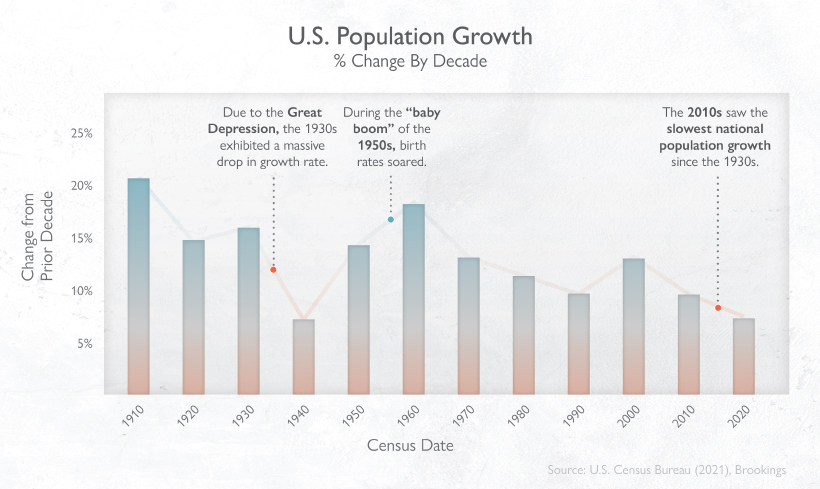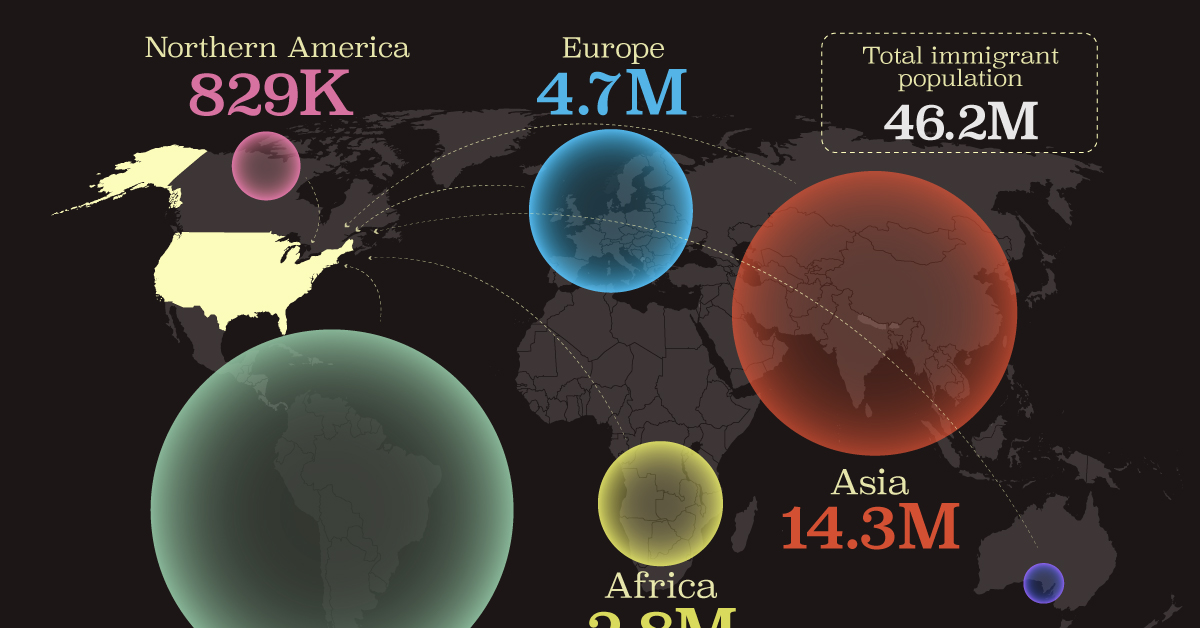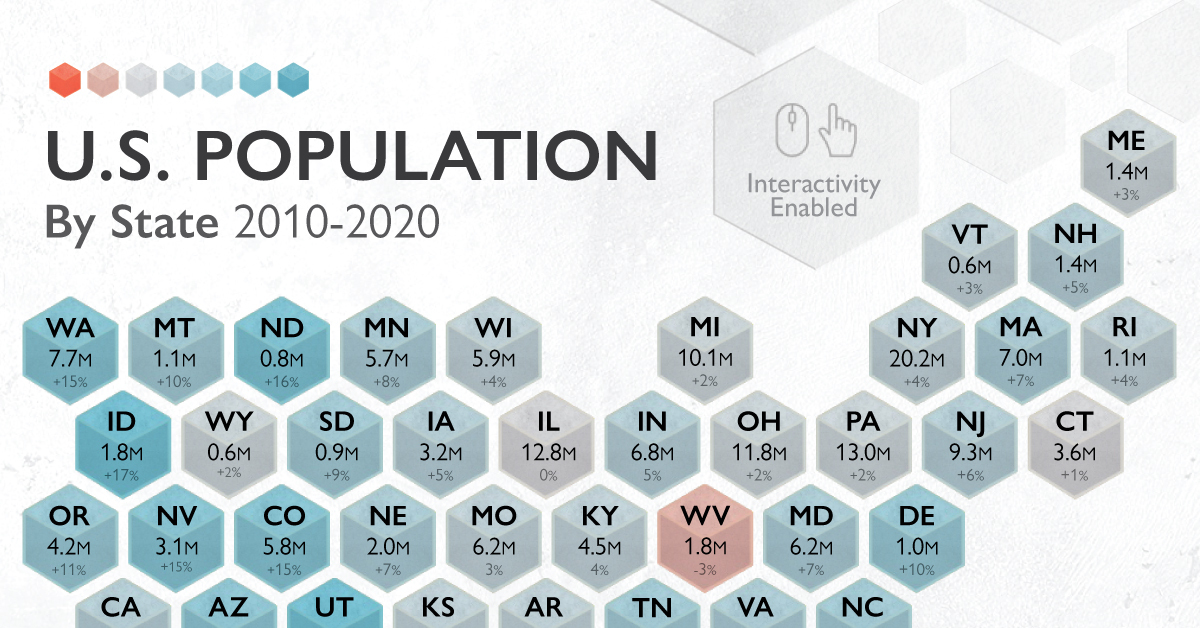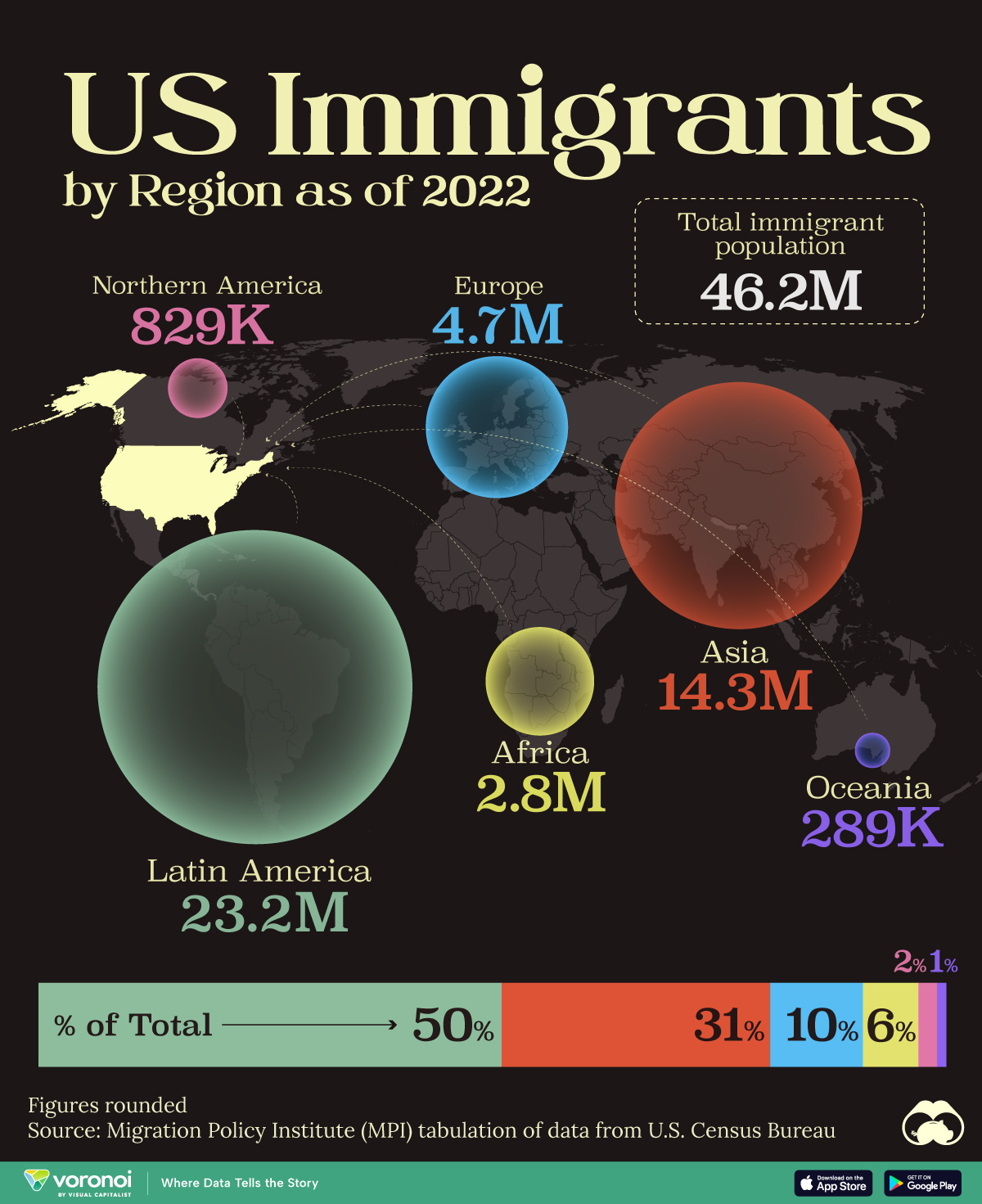Demographics
Interactive: How the U.S. Population Has Changed in 10 Years, by State
var divElement = document.getElementById(‘viz1624579073838’); var vizElement = divElement.getElementsByTagName(‘object’)[0]; vizElement.style.width=’1200px’;vizElement.style.height=’1527px’; var scriptElement = document.createElement(‘script’); scriptElement.src = ‘https://public.tableau.com/javascripts/api/viz_v1.js’; vizElement.parentNode.insertBefore(scriptElement, vizElement);
U.S. Population Change in the Last Decade, by State
The U.S. is the third most-populated country in the world, behind only two Asian giants of China and India respectively. But within the country, a lot can change in 10 years, and populations are especially mutable in nature.
As people moved in and out of certain areas for both lifestyle and economic reasons, which U.S. state populations fluctuated the most?
Drawing from the latest Census Bureau data, we look at how each state’s resident populations evolved over the past decade. But first, a blast from the past.
Historical Trends: U.S. Population Since the 1930s
Population growth trends in the U.S. have been closely tied to the economic ebbs and flows experienced by the nation. In one stark example, the country’s 10-year population growth rate plummeted to just 7.3% due to the Great Depression.

This was later offset by the post-WWII “Baby Boom”, during which birth rates soared once more, bumping up the population 10-year growth rate to 18.5% in the 1950s. The Baby Boomer generation now wields the most influence over the U.S. economy and society thanks to the favorable economic conditions in which they were born.
However, U.S. population growth rates recently hit new lows—the slower pace in the 2010s is rivalling that of the 1930s. According to Brookings, there area few factors at play:
- Falling fertility rate
- An increase in deaths (aging population, overdose deaths)
- Lower immigration rate
With all this in mind, how does the current landscape of the U.S. population by state look?
The Entire U.S. Population by State in 2020
The U.S. experienced 7.4% population growth between 2010-2020, which equates to the addition of 22.7 million people.
An impressive one-tenth of this growth occurred in California, and it remains the most populous state, rising above 39.5 million people in 2020. The SoCal megaregion—Los Angeles and San Diego—alone contributes more than $1.4 trillion to global economic output.
| Area | 2020 Census Resident Population | Numeric Change (2010-2020) | % Change (2010-2020) |
|---|---|---|---|
| Alabama | 5,024,279 | 244,543 | 5.1% |
| Alaska | 733,391 | 23,160 | 3.3% |
| Arizona | 7,151,502 | 759,485 | 11.9% |
| Arkansas | 3,011,524 | 95,606 | 3.3% |
| California | 39,538,223 | 2,284,267 | 6.1% |
| Colorado | 5,773,714 | 744,518 | 14.8% |
| Connecticut | 3,605,944 | 31,847 | 0.9% |
| Delaware | 989,948 | 92,014 | 10.2% |
| District of Columbia (Territory) | 689,545 | 87,822 | 14.6% |
| Florida | 21,538,187 | 2,736,877 | 14.6% |
| Georgia | 10,711,908 | 1,024,255 | 10.6% |
| Hawaii | 1,455,271 | 94,970 | 7.0% |
| Idaho | 1,839,106 | 271,524 | 17.3% |
| Illinois | 12,812,508 | -18,124 | -0.1% |
| Indiana | 6,785,528 | 301,726 | 4.7% |
| Iowa | 3,190,369 | 144,014 | 4.7% |
| Kansas | 2,937,880 | 84,762 | 3.0% |
| Kentucky | 4,505,836 | 166,469 | 3.8% |
| Louisiana | 4,657,757 | 124,385 | 2.7% |
| Maine | 1,362,359 | 33,998 | 2.6% |
| Maryland | 6,177,224 | 403,672 | 7.0% |
| Massachusetts | 7,029,917 | 482,288 | 7.4% |
| Michigan | 10,077,331 | 193,691 | 2.0% |
| Minnesota | 5,706,494 | 402,569 | 7.6% |
| Mississippi | 2,961,279 | -6,018 | -0.2% |
| Missouri | 6,154,913 | 165,986 | 2.8% |
| Montana | 1,084,225 | 94,810 | 9.6% |
| Nebraska | 1,961,504 | 135,163 | 7.4% |
| Nevada | 3,104,614 | 404,063 | 15.0% |
| New Hampshire | 1,377,529 | 61,059 | 4.6% |
| New Jersey | 9,288,994 | 497,100 | 5.7% |
| New Mexico | 2,117,522 | 58,343 | 2.8% |
| New York | 20,201,249 | 823,147 | 4.2% |
| North Carolina | 10,439,388 | 903,905 | 9.5% |
| North Dakota | 779,094 | 106,503 | 15.8% |
| Ohio | 11,799,448 | 262,944 | 2.3% |
| Oklahoma | 3,959,353 | 208,002 | 5.5% |
| Oregon | 4,237,256 | 406,182 | 10.6% |
| Pennsylvania | 13,002,700 | 300,321 | 2.4% |
| Puerto Rico (Territory) | 3,285,874 | -439,915 | -11.8% |
| Rhode Island | 1,097,379 | 44,812 | 4.3% |
| South Carolina | 5,118,425 | 493,061 | 10.7% |
| South Dakota | 886,667 | 72,487 | 8.9% |
| Tennessee | 6,910,840 | 564,735 | 8.9% |
| Texas | 29,145,505 | 3,999,944 | 15.9% |
| Utah | 3,271,616 | 507,731 | 18.4% |
| Vermont | 643,077 | 17,336 | 2.8% |
| Virginia | 8,631,393 | 630,369 | 7.9% |
| Washington | 7,705,281 | 980,741 | 14.6% |
| West Virginia | 1,793,716 | -59,278 | -3.2% |
| Wisconsin | 5,893,718 | 206,732 | 3.6% |
| Wyoming | 576,851 | 13,225 | 2.3% |
| U.S. Total | 331,449,281 | 22,703,743 | 7.4% |
*Note: U.S. total and 10-year percentage change includes District of Columbia but excludes Puerto Rico
Overall, there’s been a significant shift in population towards the Sun Belt region (stretching from Southeast to Southwest), where 62% of the U.S. now resides. Let’s take a closer look at the biggest gainers and decliners over time.
Gainers: Utah, Texas
Utah saw the quickest population growth rate of 18.4% in the last decade. Drawn in by strong economic prospects, net migration into the state is balancing out a decline in births. What’s interesting is that 80% of Utah’s population is concentrated in the Wasatch Front – a metro area anchored by Salt Lake City and the chain of cities and towns running north and south of Utah’s largest city.
A little further south, Texas swelled by almost 4 million residents in the last 10 years. Much of this growth took place in the “Texas Triangle”, which contains Dallas, Houston, San Antonio, and Austin. This booming region of the country contributes over $1.2 trillion to global economic output.
Decliners: West Virginia, Puerto Rico
West Virginia lost the most people in a decade, seeing a numeric population decline of 59,278. This may be explained by an aging population—16% of West Virginians are 65 years old and above.
When territories are also taken into account, Puerto Rico saw the biggest percentage decline of 11.8%, or close to 44,000 people over 10 years. Many of them moved into the mainland, and especially into Florida, after two hurricanes hit the island in 2017.
Full Speed Ahead: States Competing On Forward Momentum
By 2025, California will be home to five of the fastest-growing urban U.S. cities. The unstoppable growth of the tech industry in Silicon Valley is partly behind this, as many people flock to the West Coast to fill the shoes of highly skilled jobs required.
But could Silicon Valley one day lose its steam? Current and projected population growth in Texas is bolstering its tech potential too—in fact, it’s been dubbed the next “Silicon Hills”, with many tech companies from SpaceX to Oracle choosing to camp out in Austin instead.
Demographics
Mapped: U.S. Immigrants by Region
This map shows which regions U.S. immigrants came from, highlighting Asia and Latin America as the biggest sources.

Breaking Down America’s Immigrant Population
This was originally posted on our Voronoi app. Download the app for free on iOS or Android and discover incredible data-driven charts from a variety of trusted sources.
The United States is home to more immigrants than any other nation, surpassing the combined totals of the next four countries: Germany, Saudi Arabia, Russia, and the United Kingdom.
To add context to this impressive fact, we’ve illustrated the regions from which U.S. immigrants originated. “Immigrants” in this context refers to individuals who are residing in the United States but were not U.S. citizens at birth.
These statistics were sourced from the Migration Policy Institute, which analyzed data from the U.S. Census Bureau’s 2022 American Community Survey (ACS).
U.S. Immigrants by Region
From this graphic, we can see that Asia and Latin America emerge as the primary sources of immigration, collectively accounting for 81% of America’s 46.2 million immigrants.
| Region | # of Immigrants | % of Total |
|---|---|---|
| Europe | 4,728,948 | 10 |
| Asia | 14,349,080 | 31 |
| Africa | 2,752,965 | 6 |
| Oceania | 288,560 | 1 |
| Northern America | 828,702 | 2 |
| Latin America | 23,233,834 | 50 |
| Total | 46,182,089 | 100 |
Latin America alone contributes half of the immigrant population. Mexico stands out as the largest contributor to U.S. immigration, with 10.7 million immigrants, attributable to its geographical proximity and historical ties.
Economic factors, including wage disparity and employment opportunities, drive many Mexicans to seek better prospects north of the border.
From Asia, the two largest country sources are China (2.2 million) and India (2.8 million).
Learn More About U.S. Immigration From Visual Capitalist
If you enjoyed this post, be sure to check out Why Do People Immigrate to the U.S.? This visualization shows the different reasons why immigrants chose to come to America in 2021.
-

 Technology1 week ago
Technology1 week agoCountries With the Highest Rates of Crypto Ownership
-

 Mining6 days ago
Mining6 days agoVisualizing Copper Production by Country in 2023
-

 Politics7 days ago
Politics7 days agoCharted: How Americans Feel About Federal Government Agencies
-

 Healthcare1 week ago
Healthcare1 week agoWhich Countries Have the Highest Infant Mortality Rates?
-

 Demographics1 week ago
Demographics1 week agoMapped: U.S. Immigrants by Region
-

 Maps1 week ago
Maps1 week agoMapped: Southeast Asia’s GDP Per Capita, by Country
-

 Automotive1 week ago
Automotive1 week agoHow People Get Around in America, Europe, and Asia
-

 Personal Finance1 week ago
Personal Finance1 week agoVisualizing the Tax Burden of Every U.S. State




















